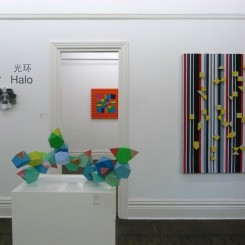Halo (solo exhibition by ZAKA)
Don Gallery (Room 26, Blackstone Apartment, No. 1331, Middle Fuxing Road, Shanghai) Sep 7 – Oct 17, 2012
Allow me to relate an unrelated story before discussing ZAKA’s artwork. Not long ago, a European acquaintance of mine working in antiques was sifting through a pile of painted Chinese fans at some rural flea market in Europe, and he purchased them for a pittance. By pure happenstance, the works were brought to an auction house in China, and appraised as genuine silk paintings from the Song Dynasty; the name of the artist had been lost through the centuries. Although not the works of great masters like Ma Yuan or Xia Gui, these anonymous Song-dynasty court fans still made considerable waves. All of the pieces were purchased at high prices by a collector, with the European successfully staging a small coup in the Chinese antiques market. For collectors, the fans’ desirability lay in their status as genuine artifacts from the Song Dynasty; their very anonymity only heightened their uniqueness as historical relics. Anonymity was a creative path for ancient artists, especially with Song painters, most of whom were all career artists. They made a living through painting for rich patrons, nobles, or members of the court, and the idea of carving a name for oneself as an artist did not really exist.
With the advent of idealism came individual creativity; it allowed the artist to step out from the shadow of his work and transformed him from an artisan into an individual with a real name and identity. His work became an expression of his desires and experiences. A well-known Chinese expression, “You are what you paint; you are what you write,” articulates this: that the work expresses the artist’s inner world. The figure of the artist soon ascended to near-mythological status and was robed in the mysterious mantle of a celebrated “master.” Hackneyed as this title might sound, it invariably became a reality. In today’s society of instantaneous, technological communication, it would be difficult for a successful artist to remain anonymous even if he chose to do so. It is precisely this inability that makes ZAKA’s exhibition that much more intriguing.
Strictly speaking, ZAKA is not an unknown artist; rather, he is a faceless artist who uses the pseudonym ZAKA to navigate the art world. Cheng Xixing, the director of Don Gallery, was first contacted by ZAKA a year and a half ago; the “artist known as ZAKA” requested that Don Gallery manage his works, with the proviso that he would never reveal his identity. For the past 18 months, ZAKA has held to his promise; all of his works are sent through couriers, with the sender’s name left blank. Sometimes, a truck will appear at the gallery with his larger pieces in tow. Any enquiries made of the driver about the artist’s identity are met with a scowl or an unreadable expression. The drivers guard their secret carefully as if they were all paid off by the artist. To date, everything the gallery knows about ZAKA is that he/they is/are Chinese and reside(s) in Shanghai.
